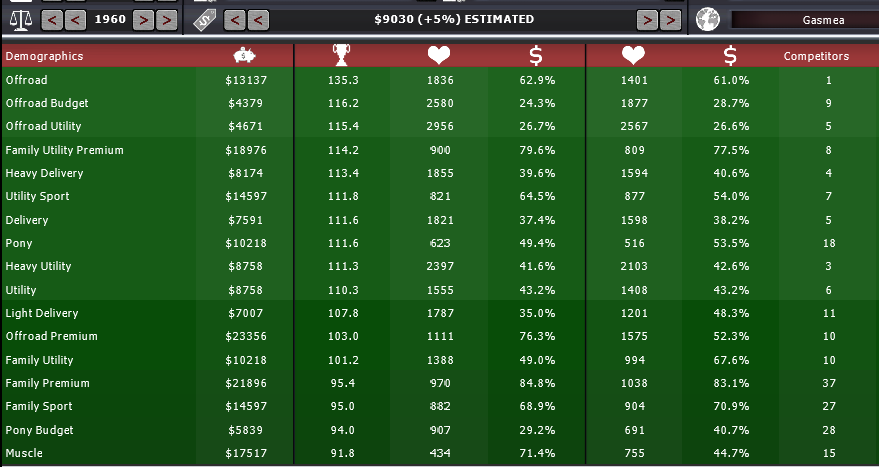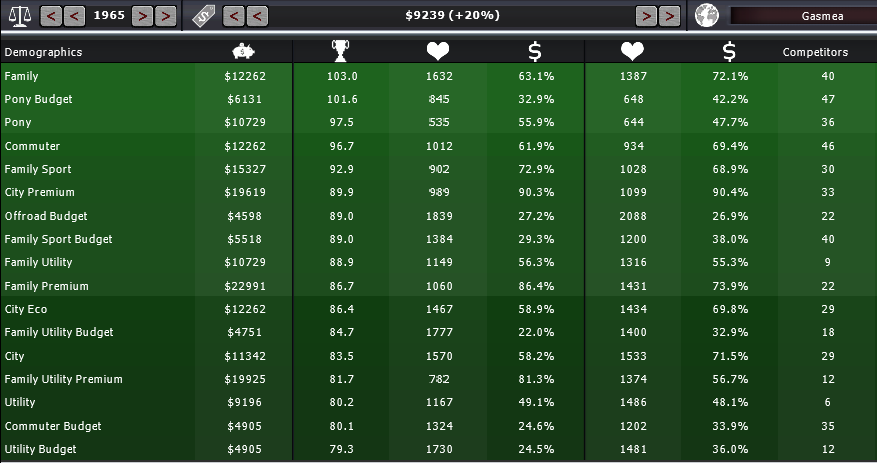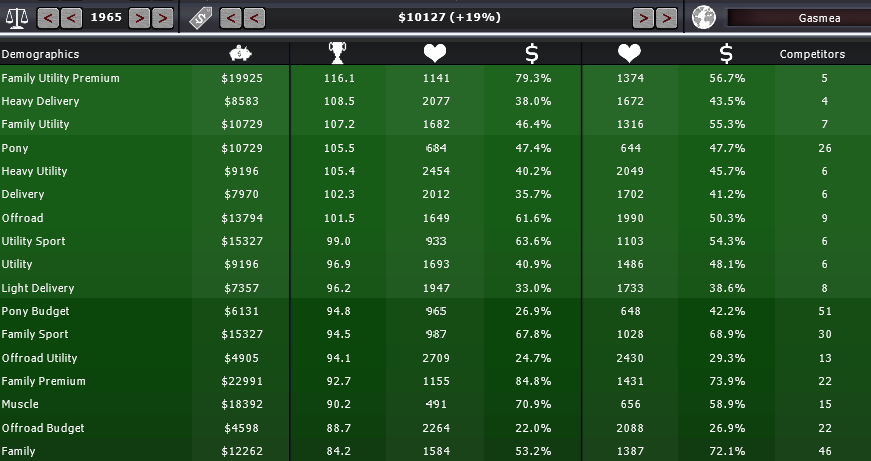What do you use to calculate the cars price at the time of production?
I call it the gold method 
I read somewhere in the forum that the automation money units were roughly based in 2010 US dollar.
And according to this page http://www.macrotrends.net/1333/historical-gold-prices-100-year-chart the price of gold in January 2010 was $1179.88 per ounce. I just convert the value of the car to ounces of gold for that year, and then back to currency for january of the year that the model was launched. The idea came from this post --> Prices, production untis and Economy questions
Thanks, I’ll have to remember to bookmark that page on my home computer later, since Im currently at school.
1960 Mástin
Following the tradition of trucks and Suv’s, ADM put to rest the old ADM-35/volcan and launched their new trucks line-up
1960 Mástin Familiar
The brand new Mastin Familiar was a basic SUV (ladder chassis, mcpherson strut front, solid leaf back) with rear wheel drive, powered by the replacement of the old Venturi 6 (1946-1959) the brand new Mastiff L6 unit. It had 3.6L of displacement with OHV configuration and a 2 barrel carb, with enough power to move the not-so-heavy suv (1275kg).
It came with 5 doors, 5 seats and std interior, with an automatic 3 speed transmission. It had no radio, but for extra money you could get one.
1960 price: $2,237.87
2 trims were offered as well, a single cab powered by the same L6 engine with a manual 4 speed transmission w/overdrive, with RWD, and a longer 4x4 version, with the same v8 as the Rivera, but with an 3 speed automatic transmission, both with manual locker diff.
1960 Mástin Cab
1960 price: $2,187.01
1960 Mástin 4x4
1960 price: $2,438.89
Holy Moly even more beautiful cars  !
!
I’m impressed
THE MID 60s
Still at 1960, ADM was partially founded and owned by the Mexican government, meaning that most of their prices were low to allow the national market to take off. But in 1961 the government decided that too much money was invested into ADM and the company was warned that they would stop receiving support by 1965.
Preparing for that, ADM managers put a lot of effort into a more aggressive international campaign, and they offer all the line-up across the whole continent. All the models were redesign (face-lift and a more intensive engineering) to compete with other makers.
Also all their new models came out with a higher price, to cover the new costs per vehicle and the lack of support by the government.
1964 Rivera
One of the first models to receive a face lift and a complete re-worked engineering was the big sedan Rivera. Only the chassis and the engine (4.9L OHV V8) along with 90% panels remained the same, but everything else was reworked.
It had 5 seats (a seat was removed to place a phonograph) with the a nice premium interior (a lot of leather and woodgrain) and the most advance safety. The brakes were solid disc front and drum brake a the rear with wider tires (in comparison to the older model).
Since it weighted a lot and had an anemic engine with a 3 speed automatic, the car was pretty slow. It did 0-100 km/h in 13.9s and it could reach a top speed of 181.7 km/h.
The Rivera was pretty good received, and the only complain was the lack of power, but must owners just re-tuned the engine and added more carbs to it.
Market price w/38% mark-up: $18,438
1964 price: $4,234.00
That is a fantastic looking car.
Thank you! If only (as KLinardo said in the car shopping round) my engineers put as much effort in the performance as the designing and styling guys 
Hmm, it seems that art is much easier to do than engineering in hot climate, like Mexican 
Let’s say that and not that my engineers are lazy xD
Moving on to another piece of work 
1964 Mastín Familiar
Sames as the Rivera, the Mastín Familiar was re-engineered and offered in 2 trims, the Familiar Base and the Familiar Clase (the one in the picture).
Powered by the old and reliable Mastin L6 (3.7L L6), the Familiar Clase was the Rivera of the SUVs. It came with an automatic 3 speed transmission, manual locker, RWD, Solid discs front-drums back, 4 seats with the same premium interior and phonograph as the Rivera. Speedwise it was painfully slow (0-100 in 15 seconds, 147 km/h top speed), but considering the roads of that time, you really didn’t need to go faster.
1964 price: $3,435.00
For those in a tighter budget, the Familiar base was offered. In the exterior, the main difference was the absence of the roof racks, but the interior and the suspension were completely different.
It had 5 seats (one more, since there was not a phonograph in the way) with barely any padding, no locker, no radio and significantly less safety gizmos. All of this made it lighter and so faster than the Clase trim. 0-100 was possibly in 13.9 seconds.
The Familiar Base trim was so succesfull that was widely used in different aplications, such as policial vehicles or ambulances.
1964 price: $2,409.00
1965 Villa Coupé
The Villa always had a difficult life. It started as a replacement for the early 50s Gomez, that wasn’t a bad seller, but it fail to attract people looking for small city cars. It received later in 1960 a facelift and a new engine. Again, failed to attract the targeted group of buyers, and ended up competing against the Quijote.
After the recent facelift, pretty much everything that is not in the outside was re worked (except the engine), this time, aiming not to city or budget buyers, but rather small families looking for a simple car for daily use or commute.
It was powered by the same 2L OHV l4 with 60hp paired to a 4 speed manual. The gearing was really short (since its top speed was only 145 km/h) to allow the engine to push easily the 1 ton car.
It had seating for 5, with a basic interior and no radio, but also had power steering and advance safety (although that was an overkill, the car was pretty slow to crash into something).
0-100km/h: eventually
top speed: 145 km/l
1965 price: $2,100.00
1965 Quijote 1st Generation Facelift
The Quijote took the name of the main character of the spanish novel titled The Ingenious Gentleman Don Quixote of La Mancha.
First introduced in 1960, it was a model designed to fill the gab between the luxurious Rivera and the cheap Villa. 5 years later, a facelift was in order, and also 2 new trims were introduced, the Coupé (a sports family car) the Sedán (a 4 doors premium saloon) and the Familiar (the first ADM station wagon).
The engineering behind it was simple, steel ladder chassis with steel panels, mcpherson strut at the front and solid axle leaf in the back. All of them used the same engine, a 2.2L OHV 4 cylinder in a FR configuration, mated to either a 4 speed manual or a 3 speed automatic. While it wasn’t the most emblematic design, it was a key model in the expansion of the company.
1965 - 1968 Quijote Coupé
- ENGINE:
In-line 4 2.2 liters OHV
Single carburetor Single barrel - FUEL:
Regular leaded
- manual 4 speed
- 5 seats
- Standard interior
- Power steering
- Advanced safety
1965 price: $2,274
1965 - 1968 Quijote Sedan
- ENGINE:
In-line 4 2.2 liters OHV
Single carburetor Single barrel - FUEL:
Regular leaded
- 3 speed automatic
- 5 seats
- Premium interior
- Premium radio
- Power steering
- Advanced safety
1965 price: $3,045
1965 - 1969 Quijote Familiar
- 3 speed automatic
- 5 seats
- Basic interior
- Power steering
- Advanced safety
1965 price: $2,111
1965 Mastín 100 & 120
While a year earlier the Mastin Familiar was presented to the market, in 1965 two new trims came to life, the 100 & the 120. Both were pickups, basically the same 60 Mastin Cab and 4x4 but with re-worked names, and better engineering.
Although both share the same chassis and over all layout, there were critical differences in the engine, the suspension and the drivetrain.
For starters, the Mastin 100 was shorter and was equipped with the same L6 as the Mastín Familiar paired to a 3 speed automatic with manual locker powering the rear wheels. The longer Mastín 120 was equipped with the Rivera’s V8 a 3 speed automatic w/manual locker and 4x4 switch, plus a more off-road oriented configuration.
1965 - 1969 Mastín 100 4x2
1965 price: $2,303
1965 - 1969 Mastín 120 4x4
1965 price: $2,706
1966 - 1968 Madero
The only spaceframe chassis ADM has ever produced. The original madero was launched in 1950 and was aimed to be a simple small car with just a sporty touch. Then in 1960 it was transformed in sort of a light sport car, with the Meliora Perenne as the closest competitor. By 1966, the car received a facelift and a re-worked engineering. But sadly, that didn’t make it faster. By that time, the car was quite slow compared to other cars, and when the new version kept the old engine, it pretty much kill the model. The demand was low, and not much cars were sold (thankfully, not many were produced either) and it only remained in production for 2 years.
1966 price: $2,321
Gorgeous colour on the Madero 
1968 - 1972 Rivera 4th Generation [corporate]– 3 trims –[/corporate]
In 1968, only 4 years after the last generation was presented to the world, the Rivera was re-newed with a brand new design, still large and prestigious and by far, the most expensive car in the ADM line-up.
3 trims were offered, with 3 different approaches (and prices). The first one is the Base, which is sort of a entry level car for those wanting to have the classic Rivera name and design in their garage. It used a new variant of the old Mastiff V8, this time producing 172hp (against the 148hp it produced before). Now, with this amount of power, there were less critics about the anemic engine.
The next trim was called GLX… for apparently no good reason other than there were some GLX badges around. This one used a beefed up version of the same V8, prepared to run on high octane leaded fuel and producing 212hp. This along with the fine tuned suspension, it gave it a nice sportier feel (despise weighting over ton and a half.
Finally, the more expensive, the presidential was the epitome of luxury. 4 seats, luxury interior with refined materials and a nice phonograph, it was perfectly suited for only the top tier politician, dictators and the like, using the same Mastiff V8 high octane.
Rivera Base

1968 price: $3,999
Rivera GLX

1968 price: $4,340
Rivera Presidencial

1968 price: $5,236
I love the fact that your cars are mexican and they really look mexican, too.
btw that’s a compliment in my book! 
@SeriousSimon Thanks, I’m glad to receive positive feedback for my models… but I don’t know how a mexican car should look  But I guess the influences of my childhood came up when I make my cars
But I guess the influences of my childhood came up when I make my cars 
1968 - 1972 Foxhunt [corporate]– 3 trims –[/corporate]
After the cancellation of the Madero, ADM was not ready to give up the sport market, dominated by the American car makers and (to some extend) by the national rival Meliora.
A few years earlier, a new project was in process, and finally in 1968 was presented the FoxHunt (the first car with a non-spanish name) named after the hound bred. Initially it was designed for racing in the American Trans-am racing, but due to lack of time and resources (it was meant as a mass produced car) at the end it didn’t participated.
3 Trims were offered, the L6 powered by a re-tuned variant of the 3.6L OHV inline 6 used in the Mastin trucks line-up, the V8 powered by the same engine as the Rivera GLX and finally the Grand Prix, which was the top of the line, using a more powerful 4.9L V8. All of them matted to classics 4 speed gearbox (a close-gear ratio in case of the Grand Prix).
Sadly, due to the lack of power, the Foxhunt is considered a Pony car and not a Muscle car, but that doesn’t diminish of what the car is capable. Thanks to its well engineer chassis (it was the first monocoque ADM car) and engine, it had a perfect weight distribution [tho it was a coincidence, since the ADM engineers are the less… experimented of all my companies] and it had a perfect sport handling, easy to control but capable of roll out the tail when you press the pedal too hard.
With a 7.4s time from 0-100 km/h, it was in the range and even faster than the
Ford Fairlane GTA 390 6.4 V8, the Ford Mustang Mach 1 351 and even the Chevrolet Camaro Z28 Sport Coupe from 1967, but a tad slower than the Dodge Dart and the Chevrolet Impala.
It was also faster than the '65 Meliora Leopardo Rally Sport (334hp) 7.5s and the '65 Kodiak Hornet 7.7s,
Foxhunt Grand Prix

1968 price: $2,799
Foxhunt V8

1968 price: $2,620
Foxhunt L6

1968 price: $2,400
If the Foxhunt looks very much like an HK-HG Monaro that’s because it practically is one, since it uses the HK coupe body from @Corvette6317, is available with a variety of OHV straight-sixes and V8s, and has a similar independent front/live axle rear suspension setup. However, I have built similar cars with this body using double wishbones at each corner, as well as a galvanized steel monocoque chassis for better environmental resistance, although they usually cost more, with the extra price being justified through the use of larger, more powerful engines and a premium interior. Then again, those cars, unlike the Foxhunt, compete in the Muscle class, not the Pony class…
And this company of yours is one of your best efforts, just like your other company. I would like to see how it evolves in the future.
















































